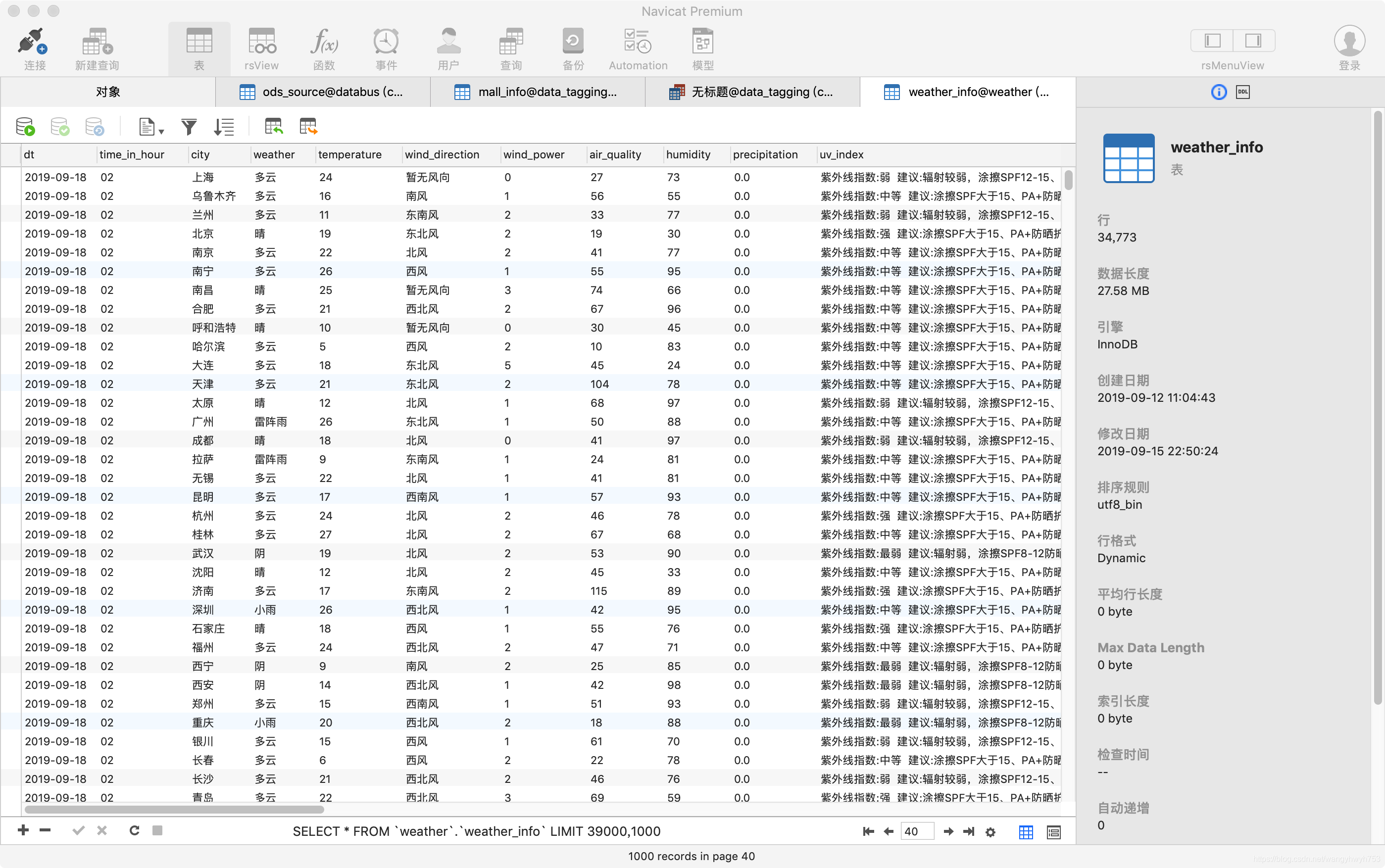Mi entorno es python3, el objetivo es rastrear la información meteorológica de las principales ciudades de China Weather Network (http://www.weather.com.cn) en la base de datos MySQL.
Primero introduzca el módulo HTMLParser, solicite el módulo de solicitud de red, el módulo pymysql (connect mySQL), el módulo json, el módulo pandas, el módulo de fecha y hora
from html.parser import HTMLParser
from urllib import request
import pymysql
import json
from get_city_code import query_city_code
import pandas as pd
from datetime import datetime,date,timedeltaEntre ellos, get_city_code es una pitón escrita por mí mismo, utilizada para consultar el código de cada ciudad en la red meteorológica. Esto se debe a que cada ciudad se muestra en una página web diferente en China Weather Network, y el nombre de la página web a menudo se nombra con un código. Por ejemplo, la página del clima de Beijing es http://www.weather.com.cn/weather1d/101010100.shtml , donde 101010100 es el código de la ciudad de Beijing, y la diferencia en la información del clima de cada ciudad está aquí.
Normalmente, el código de la ciudad debe rastrearse desde la página web. Como solo necesito los códigos de las principales ciudades, enumeraré las consultas directamente aquí. El parámetro de entrada query_city_code es un nombre de ciudad de caracteres chinos, y el parámetro de salida es un código numérico. Para más detalles, consulte https://blog.csdn.net/ljheee/article/details/54134621 . Ejemplo: query_city_code ('Beijing') devuelve el resultado como '101010100'. Cada ciudad es igual, así que aquí tenemos el clima de Beijing como ejemplo.
Primero obtenga la página web de destino de acuerdo con la dirección de la página web.
url_address = "http://www.weather.com.cn/weather1d/101010100.shtml"
req = request.Request(url_address)
req.add_header("User-Agent",
"Mozilla/5.0 (Windows NT 6.1; WOW64) AppleWebKit/537.36 (KHTML, like Gecko) Chrome/55.0.2883.87 Safari/537.36")
# 解析返回内容
with request.urlopen(req) as html:
# data为网页返回内容
data = html.read().decode("utf-8")En segundo lugar, se debe analizar el contenido de la página web obtenida, aquí se define una clase de analizador (WeatherHtmlParser), que se utiliza específicamente para el análisis de la página web meteorológica.
# 解析中国天气网HTML解析器,其继承了HTMLParser函数,主要重新定义了三个函数handle_starttag(tag,attrs),handle_endtag(tag,attrs),handle_data(data),主要是对这三个函数的理解,就能知道如何解析的。
class WeatherHtmlParser(HTMLParser):
#解析器(类)的初始化函数,这里的city表示城市的名字,date_t表示日期,需要在实力化的时候予以给定,这里主要是我爬的东西比较多(包含温度,湿度等信息),很多初始化是不必要的。
def __init__(self,city,date_t):
self.flag_daily = False
self.flag_24h = False
self.flag_index = False
self.date = date_t
self.date_next = self.get_diff_date(1)
self.city = city
self.weather_data_daily_frame = pd.DataFrame(columns=['日期','时刻','城市','天气'])
self.data_index_temp = ""
self.begin_index_cal = False
self.end_index_cal = False
self.weather_data_24h_frame = pd.DataFrame(columns=['日期','时刻','城市','温度','风向','风力','降水量','湿度','空气质量'])
self.weather_live_index_frame = pd.DataFrame(columns=['日期','时刻','城市','紫外线指数','减肥指数','血糖指数','穿衣指数','洗车指数','空气污染扩散指数'])
self.daily_frame = pd.DataFrame(columns=['日期','时刻','城市','天气','温度','风向','风力','空气质量指数','湿度','降水量','紫外线指数','减肥指数','血糖指数','穿衣指数','洗车指数','空气污染扩散指数'])
super(WeatherHtmlParser, self).__init__()
def get_diff_date(self,n):
date_diff = (datetime.strptime(self.date,'%Y-%m-%d') + timedelta(days=n)).strftime("%Y-%m-%d")
return date_diff
#这里是自定义的,用以获取标签属性值,从而更加精确定位
def _get_attr(self,attrs,attrname):
for attr in attrs:
if attr[0] == attrname:
return attr[1]
return None
# 解析器是从头到尾遍历每一个标签,参数tag是当前解析网页标签名。handle_starttag相当于处理<div></div>标签中的<div>
def handle_starttag(self, tag, attrs):
#我们发现天气信息是在<ul>标签内,并且ul标签属性"class"为clearfix内部。所以在解析器发现这个ul标签时,将预先定义的flag置为True。方便后面的handle_data处理。
if tag == "ul" and self._get_attr(attrs,'class') == 'clearfix':
self.flag_index = True
if tag == "script":
self.flag_daily = True
self.flag_24h = True
# 解析器是从头到尾遍历每一个标签,参数tag是当前标签名。handle_endtag相当于处理<div></div>标签中的</div>,注意</div>的标签tag也是div,之前以为是"</div>"还踩了各坑。这里配合handle_flag完成了一次flag的开和关。注意有可能flag会有多次的开和关,主要影响的是handle_data的处理。
def handle_endtag(self, tag):
if tag == "ul":
self.flag_index = False
if tag == "script":
self.flag_daily = False
self.flag_24h = False
#handle_data()是对标签内容进行处理,data表示标签内的内容。注意这个data表示的是最小标签内容,例如<div><p>hello</p><p> world</p><div>,如果你想获得div标签中的内容:hello world.但是这里解析的却是hello或者world。这里遇到的坑,希望能避免。
def handle_data(self, data):
#这里就体现出flag的意义了,只有flag为True(或者自设定条件)来获取想要的内容。下面是自己筛选的内容,实际上到这里整个解析网页已经结束了。
if self.flag_24h:
if "observe24h_data =" in data:
data = data.strip("\n")
data_index_od = data.index('"od2":')
data_temp = data[data_index_od+6:-3]
index_m = data_temp.rindex('}')
index_b = data_temp.rindex(']')
if index_b != (index_m + 1):
data_temp = data_temp[:(index_m+1)]+data_temp[index_b:]
print(data_temp)
# data_24 = data.strip("var observe24h_data = {'od)
weather_data_24h = json.loads(data_temp)
#self.date = weather_data_24h["od"]["od0"][:4] + '-' + weather_data_24h["od"]["od0"][4:6] + '-' +weather_data_24h["od"]["od0"][6:8]
#self.date_next = self.get_diff_date(1)
#print(isinstance(weather_data_24h,list))
weather_data_24h.reverse()
b_is_next = False
index = 0
for weather_item in weather_data_24h:
if weather_item['od22'] == 'null':
continue
if weather_item['od21'] == '00':
b_is_next = True
if b_is_next == False:
temp_item = [self.get_diff_date(-1),weather_item["od21"],self.city,weather_item["od22"],weather_item["od24"],weather_item["od25"],weather_item["od26"],weather_item["od27"],weather_item["od28"]]
else:
temp_item = [self.date,weather_item["od21"],self.city,weather_item["od22"],weather_item["od24"],weather_item["od25"],weather_item["od26"],weather_item["od27"],weather_item["od28"]]
#解析得到的温度,湿度,风向,风力等内容(对应代码中的"od21","od22"等)放到了self.weather_data_24h_frame中,这是一个pandas数据结构,后续将其依次放入mysql中
self.weather_data_24h_frame.loc[index] = temp_item
index += 1
#print(self.weather_data_24h_frame)
if self.flag_daily:
if "var hour3data=" in data:
data = data.strip("\n")
data = data.strip("var hour3data=")
self.weather_data = json.loads(data)
index = 0
for list_item in self.weather_data["1d"]:
list_item_value = list_item.split(',')
if '日' in list_item_value[0]:
index_1 = list_item.index('日')
index_2 = list_item.index('时')
date_now = list_item_value[0][:index_1]
hour_now = list_item_value[0][(index_1+1):index_2]
hour_next = str(int(hour_now) + 1)
if len(hour_next) < 2:
hour_next = '0' + hour_next
hour_after_2 = str(int(hour_now) + 2)
if len(hour_after_2) < 2:
hour_after_2 = '0' + hour_after_2
if int(hour_now) < 22:
if date_now == self.date[8:10]:
temp_item = [self.date,hour_now,self.city, list_item_value[2]]
temp_item1 = [self.date, hour_next,self.city, list_item_value[2]]
temp_item2 = [self.date, hour_after_2, self.city, list_item_value[2]]
else:
temp_item = [self.date_next, hour_now, self.city, list_item_value[2]]
temp_item1 = [self.date_next, hour_next, self.city, list_item_value[2]]
temp_item2 = [self.date_next, hour_after_2, self.city, list_item_value[2]]
elif int(hour_now) == 22:
if date_now == self.date[8:10]:
temp_item = [self.date, hour_now, self.city, list_item_value[2]]
temp_item1 = [self.date, hour_next, self.city, list_item_value[2]]
temp_item2 = [self.date_next, '00', self.city, list_item_value[2]]
else:
temp_item = [self.date_next, hour_now, self.city, list_item_value[2]]
temp_item1 = [self.date_next, hour_next, self.city, list_item_value[2]]
temp_item2 = [self.get_diff_date(2), '00', self.city, list_item_value[2]]
else:
if date_now == self.date[8:10]:
temp_item = [self.date,hour_now,self.city, list_item_value[2]]
temp_item1 = [self.date_next, '00',self.city, list_item_value[2]]
temp_item2 = [self.date_next, '01', self.city, list_item_value[2]]
else:
temp_item = [self.date_next, hour_now, self.city, list_item_value[2]]
temp_item1 = [self.get_diff_date(2), '00', self.city, list_item_value[2]]
temp_item2 = [self.get_diff_date(2), '01', self.city, list_item_value[2]]
self.weather_data_daily_frame.loc[index] = temp_item
index += 1
self.weather_data_daily_frame.loc[index] = temp_item1
index += 1
self.weather_data_daily_frame.loc[index] = temp_item2
index += 1
#print(self.weather_data_daily_frame)
if self.flag_index:
self.data_index_temp += data
self.begin_index_cal = True
else:
self.begin_index_cal = False
if self.data_index_temp and not self.begin_index_cal and not self.end_index_cal and "紫外线指数" in self.data_index_temp:
data_index_str_list = self.data_index_temp.split("\n")
data_index_1 = data_index_str_list.index('紫外线指数')
data_index_2 = data_index_str_list.index('减肥指数')
data_index_3 = data_index_str_list.index('健臻·血糖指数')
data_index_4 = data_index_str_list.index('穿衣指数')
data_index_5 = data_index_str_list.index('洗车指数')
data_index_6 = data_index_str_list.index('空气污染扩散指数')
for index in range(24):
temp_item = []
temp_item.append(self.date)
hour_temp = str(index)
if len(hour_temp) == 1:
hour_temp = "0" + hour_temp
temp_item.append(hour_temp)
temp_item.append(self.city)
temp_item.append(
'紫外线指数:' + data_index_str_list[(data_index_1 - 1)] + ' 建议:' + data_index_str_list[(data_index_1 + 1)])
temp_item.append(
'减肥指数:' + data_index_str_list[(data_index_2 - 1)] + ' 建议:' + data_index_str_list[(data_index_2 + 1)])
temp_item.append(
'血糖指数:' + data_index_str_list[(data_index_3 - 1)] + ' 建议:' + data_index_str_list[(data_index_3 + 1)])
temp_item.append(
'穿衣指数:' + data_index_str_list[(data_index_4 - 1)] + ' 建议:' + data_index_str_list[(data_index_4 + 1)])
temp_item.append(
'洗车指数:' + data_index_str_list[(data_index_5 - 1)] + ' 建议:' + data_index_str_list[(data_index_5 + 1)])
temp_item.append(
'空气污染扩散指数:' + data_index_str_list[(data_index_6 - 1)] + ' 建议:' + data_index_str_list[(data_index_6 + 1)])
self.weather_live_index_frame.loc[index] = temp_item
self.end_index_cal = TrueFinalmente, use el analizador anterior para analizar la página web que acaba de obtener
#实例化解析器,得到对象html_parser
html_parser = WeatherHtmlParser(city_name, date.today().strftime('%Y-%m-%d'))
#将网页内容data送给对象html_parser解析
html_parser.feed(data)
#html_parser结束解析
html_parser.close()
#处理对象html_parser的相关内容,这里入了Mysql库。
put_result_to_sql(conn, html_parser.weather_data_daily_frame, html_parser.weather_data_24h_frame, html_parser.weather_live_index_frame)Entrar en la biblioteca MySQL no comenzará, veamos el efecto.
